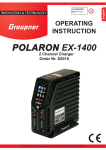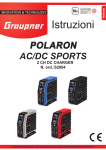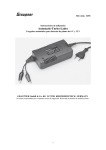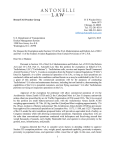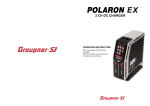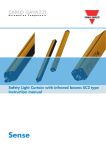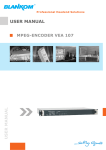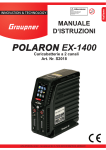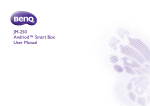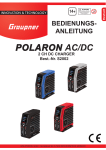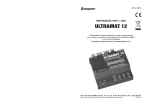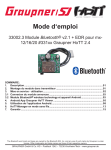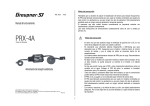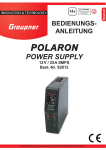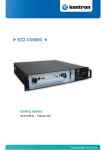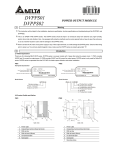Download Graupner POLARON EX1400 Charger - Manual
Transcript
POLARON EX-1400 2 Channel Charger Order Nr. S2018 GRAUPNER/SJ GmbH • Henriettenstr.96, D-73230 KIRCHHEIM/TECK GERMANY English OPERATING INSTRUCTION English Content table Introduction........................................................ 3 Symbols explanation......................................... 4 Safety instructions............................................. 5 Notes on batteries handling .............................. 6 Capacity and use time................................... 7 Disposal of waste batteries........................... 7 Environmental information................................ 8 General operating information........................... 8 Declaration of Graupner|SJ GmbH.................... 10 Intended use.................................................... 11 Care and maintenance.................................... 11 Package content.............................................. 12 technical specifications............................... 13 Operating elements......................................... 14 Commissioning................................................ 15 Basic operations.............................................. 16 Control buttons............................................ 17 Menu PROFILE............................................... 17 Menu CHARGE............................................... 18 Adjustable Parameters................................ 19 Charge modes of different battery types..... 21 Menu DISCHARGE......................................... 24 Adjustable Parameters................................ 24 Discharge modes........................................ 25 Menu CYCLE.................................................. 28 Adjustable Parameters................................ 28 Menu BALANCE.............................................. 33 Menu DATA...................................................... 35 Menu TOOLS.................................................. 37 Submenu “SERVO“..................................... 37 Submenu “MOTOR“.................................... 38 Submenu “HEATING“.................................. 40 Submenu “E.S.C“........................................ 41 Menu SETTINGS............................................ 43 Menu STORAGE............................................. 44 <Factory settings>........................................... 45 Display “1. Factory reset“............................ 45 Display “2. Display calibration“.................... 45 Display “3. Resource Update“..................... 46 Display “4. BLC Port Test“........................... 46 Firmware update............................................. 47 Alert messages................................................ 48 Troubleshooting............................................... 51 Declaration of conformity................................. 54 Warranty.......................................................... 55 2 Introduction Thank you for choosing a Graupner Polaron charger. This charger is extremely powerful and can be used by both beginners and experts. Please read this manual carefully to get the best results with your charger and charge your batteries safely. If you experience any trouble during operation, take the manual for help or ask your dealer or Graupner service center. Due to technical changes, the information in this manual may be changed without prior notice. This product complies with national and European legal requirements. To maintain this condition and to ensure safe operation, you must read this manual and all safety instructions before using the product! NOTE This manual is part of this product. It contains important information concerning operation and handling. These instructions have to be stored securely and in case of transfer of the product they should follow it by the next owner. All company and products names are trademarks of their respective owners. All rights reserved. For technical questions, please contact our customer service, see page 55. DANGER! Before operating your new charger be sure to read the instructions completely. Please follow the instructions for disposal and environmental protection on page 8. 3 English INNOVATION & TECHNOLOGIE English Symbols explanation Safety instructions ATTENTION! This symbol highlights the nearby and following instructions, which must be observed by the user! Any disregard these warnings can affect the safe operation and the safety of the operator. This symbol WITHOUT specific heading highlights the nearby and following notes and tips, which should be strictly observed by the user! A breach of these notes and tips can result in damages of any kind. WARNING This symbol highlights prohibitions which must be strictly observed by the user! Any failure to comply with these restrictions may affect the viability and safety of the operator. CARE AND MAINTENANCE This symbol highlights notes produced for the care and maintenance of the product, which should be strictly observed by the operator to ensure long life of the product. NOTE This symbol highlights instructions, which should be strictly observed by the operator to ensure safe operation of the unit. TIP This symbol highlights tips and experiences out how you can avoid potential problems or damage and provides assistance to resolve any issues. DISPOSAL INSTRUCTIONS This symbol highlights the following points as individual materials or products must be necessarily disposed of by the users! 4 • • • • • • • • • • • • • • ATTENTION! • Damage caused by failure to comply with these instructions will invalidate the warranty / guarantee. For further damages we do not assume any liability! • We do not assume any liability for damage to property or personal injury caused by improper use or non-observance of safety instructions! The charger must be protected from dust, moisture, rain, heat (as sunshine) and vibration. Only to be used in dry conditions! The case slots serve to cool the charger and must not be blocked or covered. The unit must be installed so that the air can circulate freely. Do not plug more than one charger into a power strip! It may produce acute danger of line congestion and consequently fire! The charger has to be connected to a 12 V or 24 V car battery or to a suitable stabilized power supply with 11 ... 28 V DC output. Never connect an AC voltage on the DC input! There is a serious risk of fire! No change-ups may be performed. The charger and the battery to charge must be placed during operation on a non-flammable, heat-resistant and electrically non-conductive pad! Do not place directly on car seats, carpets or similar! Also flammable or highly flammable materials must be placed away from the charging station. Ensure good ventilation. Batteries may explode and / or burn through a defect! Connect the charger with the original connection cables and terminals directly to the car battery. As long as the charger is connected to the car battery, the car engine MUST be off! The car battery cannot be charged simultaneously from another charger! Between the charging ports and the vehicle body it is possible to have battery short circuit! Therefore, never use the charger directly to the vehicle body. The charge output and connecting cables must not be modified or connected to each other in any way. Charging and connecting cable must not be wound up during operation! Do not leave the charger unattended when connected to the power supply. Operate your charger only in rooms with a smoke detector. Connect only a battery that has to be charged to respective charging port. The following batteries must not be connected to the charger: ○○ NiCd / NiMH batteries with more than 16 cells, LiFe / Li-Ion / LiPo batteries with more than 8 cells, lead-acid batteries with more than 12 cells. ○○ Batteries which require a different charge method from NiCd, NiMH, lithium or lead-acid batteries. ○○ Defects and / or damaged cells or batteries. ○○ Batteries connected in parallel or with different cells. ○○ Mixed batteries with old and new cells, or cells with different features. ○○ Non-rechargeable batteries (dry cells). There is a serious risk of explosion! 5 English INNOVATION & TECHNOLOGIE English ○○ Batteries and / or cells that are not expressly approved by the manufacturer for the charging currents occurring during charging with this charger. ○○ Already fully charged or hot, or not completely empty cells or batteries. ○○ Batteries or cells with integrated charging or disconnecting device. ○○ Batteries or cells that are installed in a device or that are electrically connected to other components. • To avoid short circuits between the banana plugs fitted to the charge leads, please always connect the charge leads to the charger and only then to the battery! When disconnecting, proceed in reverse order. • When charging a transmitter, an interruption of charge can - even for short periods -, let the charge voltage rise in such a way that the transmitter is destroyed by the overvoltage immediately. Risk of fire! Notes on batteries handling • • • • • • • • • • • • • • • 6 Batteries, and also individual cells are not toys and should be kept out of the reach of children. Before each use, check the proper condition of the battery. Do not use defective or damaged cells / batteries. Overcharging and deep discharge lead to irreparable damage to the cells and damage permanently the capacity of the battery. Never store batteries uncharged, discharged or partially charged for long periods. Before storing batteries charge them and from time to time check charge status. NiMH cells should be 1 V per cell and Lilo / LiPo cells should never be less than 3 V per cell, in order to achieve an optimum service life. Overcharging also damages the capacity of the battery. Therefore do not charge any hot or charged batteries again. High power charge and discharge shorten the life expectancy of the battery. Therefore, do not exceed the rates stated by the manufacturer. Lead-acid batteries are not high power rechargeable. Never exceed the maximum charge rate stated by the battery manufacturer. When buying batteries ensure good quality, first charge new packs at low rates, and work up gradually towards higher currents. Charge the battery just before you want to use them, the batteries are at their most power. Rechargeable batteries / cells must not be heated, burnt, short-circuited or overloaded with excessive or reversed polarity currents. Batteries cells connected in parallel with combination of old and new cells, different features as capacity and voltage, made by different manufacturers, brands or types should not be used. A built-in battery in a device should be removed whenever the device is not used. Always turn off equipment after use to avoid deep discharge. Recharge the batteries just for the right time. The battery to charge should be placed when charging on a non-flammable, heat resistant and non-conductive pad! Also flammable or highly flammable materials must be placed away from the charging station. Batteries must be charged only under supervision. Observe the maximum specified charge rate for the specific cell type. Charge current must never be exceeded. Should the battery heat during charge to more than 60 ° C, the charge must be stopped immediately and the battery must be cooled to about 30 ° C. Never charge batteries that are hot or not discharged to the rated discharge voltage. • No changes should be made to the batteries. Never solder or weld directly to the cells. • Released electrolyte is corrosive, not allow contact with skin or eyes. In an emergency, rinse immediately with plenty of water and then consult a doctor. • Suitable extinguishing media are extinguishing blankets, CO2 estinguishers and sand. • The valve openings of the cells must not be blocked or sealed in any case, for example by soldering. When soldering do not exceed a temperature of 220° C and for a period not longer than 20 seconds. • To avoid deformation, do not produce an excessive mechanical pressure. • If a battery is overheated, proceed as follows: Disconnect the battery and place it on a non-combustible surface (stone floor) until it has cooled. Never keep the battery in your hand to avoid the risks of fire and / or explosion. • Protect batteries from vibration, and do not expose to mechanical stresses. • When charging and during operation of the batteries, they can generate explosive gas (hydrogen), be careful with adequate ventilation. • Never short circuit the batteries. This might cause fire and / or explosion! • Batteries may explode or burn through a defect. We therefore recommend that all lithium, NiCd and NiMH batteries, should be charged in a LiPo safety case Order Nr. 8370 or 8371. • Do not open batteries, chemical burn danger. • NiCd or NiMH battery packs perform their best by first individually all cells are discharged separately and only then the entire battery pack is charged. Discharging should be done by the charger cell by cell. • Make sure that the charge-discharge are done properly. • Charging single NiCd or NiMH cells or batteries with 1 ... 4 cells, can be difficult for the automatic shut-off. Since the onset after the full load point voltage drop is not very pronounced, the automatic shut-off cannot or do not respond properly. The correct operation cannot be guaranteed in this case. Be sure to check through multiple, monitored test charges, if a proper shutdown occurs for the batteries you are using. There is a serious fire and / or explosion risk! Capacity and use time For all current sources applies: The capacity decreases with every charge. At low temperatures the internal resistance increases reducing the capacity. As a result, the ability to provide power and holding the voltage can be reduced. Frequent charging and / or discharging programs can also lead to a gradual reduction in capacity. However, current sources should be reviewed at least every 6 months on their capacity, and replace them if there is a significant loss of capacity. Use only genuine Graupner batteries! Disposal of waste batteries Every consumer is legally obliged under the German battery ordinance to return all used and exhausted dry and rechargeable batteries. Disposal in the household waste is prohibited. Old batteries can be brought to the public collection points or given at our retail outlets and wherever batteries of the same type are sold. You can return used batteries sent by us to the following address: Graupner|SJ GmbH Service: Gebrauchte Batterien Henriettenstrasse 96 D-73230 Kirchheim unter Teck You make a significant contribution to environmental protection! 7 English INNOVATION & TECHNOLOGIE English DANGER! Damaged batteries need a special packaging for shipping because they are very toxic!!!!! Environmental information DISPOSAL INSTRUCTION This symbol on the product, user manual or packaging indicates that this product must not be disposed of with other household waste at the end of its life. It must be handed over to the applicable collection point for the recycling of electrical and electronic equipment. The materials are recyclable as marked. By material recycling or other forms of re-usage you are making an important contribution to environmental protection. Batteries and accumulators must be removed from the device and disposed of at an appropriate collection point. Please inquire if necessary from the local authority for the appropriate disposal site. General operating information • When charging the battery it is supplied a certain amount of electricity, which results from multiplying charge current by charge time. The maximum amount of power depends on the capacity of each battery and the maximum charge current according to the battery type. Both values are given in the specifications of the battery manufacturer. Only when explicitly rated, fast rechargeable batteries can exceed the normal charging rate. As STANDARD CHARGE CURRENT, is referred to the 1/10 of nominal capacity: (1/10 C) for a battery with a capacity of 1700 mAh the standard charge current is 170 mA. • The battery should be connected using a suitable charger cable to the connection terminals of the charger (red = positive, black = negative). Use only original charging cable with sufficient cross-section. • Always follow and observe the recommended charge currents and charge times as rated in the instructions of the battery manufacturer. Only batteries which are expressly suitable for quick charge can be charged with the high charging currents provided by this charger. • Please keep in mind that new batteries reach their full capacity after several charge / discharge cycles. Some new or deep discharged batteries may also have premature charge termination. • Should, after a fast charge, a cell of the NiXX battery packs have become particularly hot, this may indicate a defect of that cell. This battery pack should no longer be used! (Used batteries have to be disposed of as special waste!). • Since the charger can only detect the total resistance, but does not distinguish between internal resistance of the battery, cable resistance and connector transfer resistance, the first requirement for a proper function is a charging cable with sufficient cross-section and a length of not more than 30 cm with high performance connectors (gold contacts). • A transmitter built-in battery can be charged via the fitted charge socket. • Transmitters are often included with a reverse current protection in the form of a diode. This prevents damage for the transmitter from reverse polarity and short circuit between the bare ends of the charging cable connector. Depending on the design of this diode CAN however even hinder a correct recognition of the state of charge by the automatic charger. • The maximum allowable charge current for the transmitter must never be exceeded. • To prevent internal damage to the transmitter due to overheating due to a fast charge, the transmitter battery should be removed from the transmitter battery compartment. • The transmitter MUST be switched „OFF“ (OFF) during the charging process! • Never turn on the transmitter when it is connected to the battery charger. • Do not discharge the battery through maintenance programs via the charge socket! 8 • • • • • The charge socket is not suitable for this use. The charger sets the required charging current only as long as the technical possibilities of the charger are not exceeded! Should it be provided a charging current that the charger technically cannot afford, the value will be automatically reduced to the maximum possible value. In this case, the actual charge current will be shown in the display. Make sure to check after a „finish“ message that the displayed charge rate shown by the unit is the same you expected. So you can recognize reliable and timely incorrect shutdown. The probability of false indications depends on many factors, most likely with deep discharged batteries, low cell counts and particular cell types. Make sure, by several test charges, especially on low cell numbers, of the proper function of the automatic shut-off. Under certain circumstances, fully charged batteries are not detected by a weak peak, resulting in fire and / or explosion hazard! The charger might not detect automatically the connected battery type, LiPo or NiMH, in this case the battery type and the appropriate charge mode must be selected manually! Consequently, please be sure to check before charging: Is this the appropriate charge program, the correct charging current is set? Failure to comply may result in fire and / or explosion! Are all connections securely firm, or is there an intermittent contact? Please keep in mind that the rapid charging of batteries may be dangerous. A break, even for a short time, for example due to an intermittent contact, leads inevitably to malfunctions, may trigger a restart of the charge and totally overloaded the pack. This represents a fire and / or explosion risk! 9 English INNOVATION & TECHNOLOGIE English Declaration of Graupner|SJ GmbH Content of the Declaration If there are defects in material or workmanship for one of acquired object sold by us or by our dealer in the Federal Republic of Germany (§ 13 BGB) we, Graupner/SJ GmbH, Kirchheim/Teck provide in following circumstances the removal of defects for this item. Graupner/SJ GmbH assumes no liability for non-approved parts or accessories from other manufacturers and cannot judge all third party product, whether it can be safely used. The consumer cannot claim rights under this declaration if there is impairment of the usability of the product due to natural wear, use under competition conditions, misuse (including installation) or external influences. This declaration does not affect the legal or contractual rights regarding arising defects and defects rights of the consumer for the purchase contract between him/her and the vendor (dealer). Extent of Warranty Both the adherence to the operating instructions as well as the conditions and methods of installation, operation, use and maintenance of this charger are not monitored by Graupner/SJ GmbH. Therefore Graupner/SJ GmbH accepts no liability for any loss, damage or expense arising from the improper use or operation in any way. In case of warranty we provide at our choice to repair or replace the defective goods. Further claims, in particular claims for reimbursement of costs associated with the defect and the compensation for consequential damages (installation/removal costs) are - where allowed by law excluded. Claims on legal regulations, especially under product liability law remain unaffected. Guarantee requirements The buyer has to make the guarantee claim in written form, enclosing the original proof of purchase (as invoice, receipt, delivery note) located on the inside back cover guarantee card. He must send the defective goods to us at his own cost to the following address. Firma Graupner/SJ GmbH, Serviceabteilung, Henriettenstr. 96, D-73230 Kirchheim/Teck The purchaser should state the material or workmanship or the symptoms of the fault so concrete that we can check if our guarantee obligation is applicable. The transport of the defective object from the consumer to us and repatriation is a risk of the consumer. Intended use The Graupner Polaron EX-1400 you have acquired is a professional product with superior properties. By using advanced semiconductor technology and a powerful microprocessor with superior charging characteristics, simple operation and optimum reliability are achieved. With the Graupner Polaron EX-1400 it is possible to charge all model batteries such as: Nickel Cadmium (Ni-Cd), Nickel-Metal Hydride (Ni-MH), Lithium Polymer (LiPo), Lithium Ion (Lilo), Lithium Iron (LiFe), Lead-Gel and Lead-acid (Pb). Connect the charger to a car battery or preferably to a power supply with a stabilized direct current output of 12 ... 24 V and 25 A output power (recommended Order Nr. S2012). Please note: If the supply voltage drops below 23 V, the maximum possible power of the charger is not reached (see also section „Technical specifications“ on page 13). NOTE It is important to observe the charge instructions of the battery manufacturer and observe the recommended charge currents and charge times. Only batteries which are expressly suitable for high charge currents should be charged quickly! Please keep in mind that new batteries do eventually reach their full capacity after several charge/discharge cycles, and can result in premature charge cutoff. Make sure after several charges of the proper and reliable operation of the automatic charge termination circuit and the charged capacity. ATTENTION! Obey all safety messages in this manual. They contain important information on handling the product. You are responsible for the safe operation of the product! Not following the manual and safety instructions will void the warranty. They are required different connectors with several requirements in the use and application of rechargeable batteries of different kind. Note that connectors, connector names and polarities of other manufacturers may be different. Therefore, use only genuine matching connectors of the same design. Also, use only original charging cable with sufficient cross-section. Care and maintenance The charger is maintenance-free and requires no maintenance. However, please protect it in your own interest from dust, dirt and moisture! Disconnect the car battery and battery for cleaning the charger, and use only a dry cloth lightly rub (do not use cleaning agents). Period of validity This statement is valid only during the claim period for us asserted claims from this declaration. The claim period is 24 months from date of purchase by the consumer from a dealer in the Federal Republic of Germany (date of purchase). If defects are evidenced after the claim period or if required evidence or documents for the recovery of defects as under this declaration, are submitted after the expiry of the claim period, then the buyer has no right or claims from this declaration. Limitation If we do not recognize a properly asserted within the claim period, all claims from this declaration after 6 months from the date of the establishment shall be barred, but not before the end of the claim period. Applicable law Claims, rights and obligations resulting from this declaration are only valid to the pertinent German Law, without the rules of private international law, so as the UN Sales Convention. 10 11 English INNOVATION & TECHNOLOGIE English Package content The set includes: • Graupner Polaron EX-1400 Charger • 2x EH to XH 8S Adapter boards and 8S cable • USB cable (USB-A to mini-B-USB 5poles) • 1 Input cable • 2 Temperature sensors • 2 charge cables • 2 crocodile clips • 1 charger stand • Operation manual technical specifications Charger and power supply in general Display Operating voltage range Required car battery Required power supply Suggested power supply 3.0 „Color TFT LCD Touch Screen 11 ... 28 V DC (direct current) 12 or 24 V with at least 60 Ah capacity 12 ... 28V DC with at least 25A polaron power supply 12V DC 25A, Order Nr. S2012 Maximum charging power ... ... At 12 V supply voltage ... At 24 V supply voltage Undervoltage cutoff Safety timer Weight Dimensions 700 W 1400 W 10.7V 10 ... 900 mins, off about 1485 g with Stand (W x D x H) 88.2 x 203.4 x 196,3mm Connections Battery ports Charging current / power per port Discharge currents / power per port Battery memory per port USB charging port Balancer port Temperature sensor Charge distribution 2, independently settable 0.1 ... 30 A / max. 560 W at 28 V supply voltage 0.1 ... 10 A / max. 60 W 20 memories B-Type, 5 V and max. 2.5A Output Power Graupner / EH, 1 ... 8 LiPo / Lilo / LiFe cells 10 ... 80 ° C / 50 ... 176 ° F by default 50% / 50% Ni-Cd & Ni-MH batteries* Cell number Charging process Delta-peak Trickle charging Cycles Adjustable Direction Adjustable capacity range 1 ... 16 cells | charge, discharge cycle automatic, normal, linear NiCd 5 ... 25 mV / cell, NiMh 3 ... 15 mV / cell Off, <500 mA, automatic (1/20 of the charge current) 1 ... 10 cycles, wait time adjustable 1 ... 30 min Charge → discharge, discharge → charge 10 ... 150% Lithium batteries* Cell number Charging method Cell voltages Adjustable capacity range Charge rate TCS capacity Balancing current 1 ... 8 cells | Charge, discharge, storage mode normal, fast 3.3V (LiFe), 3.6 V (Lilo) and 3.7 V (LiPo) 10 ... 120% 1 ... 5C 10 ... 100% max. 1000 mAh Lead batteries* Cell number Cell voltage 1 ... 12 cells | charge, discharge 2V * Information for each battery terminal 12 13 English INNOVATION & TECHNOLOGIE INNOVATION & TECHNOLOGIE Front sight Right side sight English English Upper sight Operating elements Back sight 1 10 2 3 4 8 11 5 6 7 12 13 9 14 15 10 Nr. 1 2 3 4 5 6 7 8 9 10 Description 3.0 "Color TFT LCD Touch Screen LED indicators for charge / discharge Push button to switch between CH1 and CH2 Charge / discharge status bar Battery port Balancer port Port for temperature sensor XT90 connector to connect the power supply to the charger Fans Lateral docking jacks for separately sold AC adapter, Order Nr. S2012 ATTENTION! • If the Graupner Polaron EX-1400 is connected through the XT90 connector, located on the back, to an external power source, such as a car battery, there is current on the other plugs, located on the side (red on the bottom front part and black on the upper back part). Never connect these jacks one another!!! • Disconnect the docked Polaron power supply 12 V DC 25 A, Order Nr. S2012, from the charger Polaron EX-1400 before you connect the charger to any other external power source. Otherwise, the power supply load on the charger docking connection plugs will be added unnecessarily to the external power source. • Never shortcircuit the two charge ports. • Never connect two separate, but interconnected to the negative poles battery packs, to both charge ports. 14 Nr. 11 12 13 14 15 Description Mini-USB connector for resource and firmware updates, see pages 46 and 47, and for reading out data via PC or laptop using the “PC software” available for Polaron chargers in the download area of the product. USB charging plug 5V / 2.5A (Not suitable for connection of PC or Laptop!) Connection for external modules, see page 41 Connection for sensors of brushless motors, see page 37 Connection for servo test function, see page 37 Commissioning Connect the Graupner Polaron EX-1400 charger through the supplied cable to terminals on your car battery with 12 or 24 V or alternatively to a suitable power supply with an output voltage of 12 ... 28 V DC stabilized power and output power of at least 25 A. The optional polaron PSU, Order Nr. S2012 has to be docked to the left side. Remove the unit stand from the charger by first pushing it forward gently and then remove it from the bottom of the charger. Drag afterwards the unit base apart and, after connecting the power supply plugs, insert it under both devices. The power source and the charger will be connected through the black wire to the negative terminals (-) and the red to the positive (+)! The charger is indeed equipped with reverse polarity protection, so that incorrect insertion does not generate an immediate destruction of equipment. However, it cannot be started. Disconnect the power cable and then insert it again with the correct polarity. INSTRUCTIONS • Protect your power source, but especially your car battery, to the possibility of overloading by specifying corresponding limits in the second screen of the “Settings“ menu, 15 English page 43. • You can correct date and time in the third screen of the menu “Settings“, page 44. • The device name is displayed by default in the basic display below the date and time, you can replace it with your name or any other name with a maximum length of 12 characters in the fourth screen of the menu “Settings“, page 44. Basic operations The Graupner Polaron charger series are equipped with a touch-sensitive screen. You just have to touch the icon you want to tap or the desired option with a finger or with the pen placed in the right side to go to the desired menu item or to activate the item to set. After switching on the device and the passage of the Start Ads, it will appear on the display of Graupner Polaron EX-1400 the main screen of the device as shown on the left. Among other things on the top of the screen it displays the date and time*. From this basic display, you can switch out with a finger or the supplied pen placed in the right side arbitrarily in each of the available sub-menus by pressing the corresponding icon. The selected icon becomes briefly gray after tapping and you hear a tone. Then the selected page is displayed. With a press of the central blue pushbutton below the display or pressing the CH1 or CH2 labeled buttons at the bottom of the screen, you can switch between the charging terminals CH1 and CH2. The chosen charging port is highlighted in red. A data exchange between the two charging terminals is not possible. Only through the simultaneous connection of two identical lithium pack to charge output CH1 and CH2, it is possible to control in parallel charge port 1 and port 2, by the choice of charging modes menu of CH1 [CV-LINK], see page 21. If the battery charger is firstly not responding as expected, check foremost the settings. But if you have made your settings in the options of that charge channel (CH1 and CH2) in particular, check to which one your battery is connected. * The abbreviations “AM“ (ante meridian = before noon) and “PM“ (post meridiem = after noon) derived from Latin and are used among others in the English language. Menu name PROFILE CHARGE DISCHARGE CYCLE BALANCE DATA TOOLS SETTINGS STORAGE 16 Short description battery name, type, capacity, number of cells, memory nr., Memory Copy set and activating the charge function set and activate the discharge function set the ... ... Cycle mode: charge/discharge, discharge/charge, 1x discharge/charge/discharge ... Number of cycles: 1 ... max. 10 ... Pause between cycles: 1 ... 30 minutes (The charge or discharge parameters have to be setted in the menu “CHARGE“ or “DISCHARGE“) Displays cell voltages and related data, balancer data setting Selecting and view of device and battery data Servo tester, motor setup, tire warmers, setup function for telemetry capable Esc Entering data for power supply, alarm thresholds, date / time, name, etc. With this option, all usable lithium batteries can be placed on the optimum storage condition. Control buttons ENTER button Press this button to confirm the current setting and disables the active setting page. In addition, press this button to return to the previous page and changed data is stored. Press this button to change if necessary one page down or reduce setting values in the selected fields. Press this button to change if necessary one page up or increase setting values in the selected fields. Press this button to change if necessary to the nearest side of the display; start a process or store the entered data. CPY button Press this button to copy values or settings. Push button on the front 1.With a press of this button changes between CH1 and CH2. 2.Press and hold during power up: Recall the <Factory Default>, see page 45 ESC button DEC button INC button Menu PROFILE In the “PROFILE“ menu you store the data of your batteries and complement them with the respective charge/discharge parameters in the “CHARGE“ and “DISCHARGE“ menus. The data on the currently active charge channel (CH1 / CH2) are displayed by default for the last battery memory selected after opening this menu. To change this selection, you have to tap on the upper “memory location“ field with your finger or with the supplied pen placed in the side of the device. Choose the desired memory location 0 ... 19 in the blue area via the INC / DEC buttons at the bottom of the display. Tapping again the field deactivates the choice. “Upper” Settings Field 01 “BATTERY NAME“ Type Volt (Voltage) Capac. (Capacity) Description Number and name of the selected memory location Battery type (NiCd, NiMH, LiIo, LiPo, LiFe, Pb) Cell number from type and cell voltage resulting from battery voltage Battery capacity 17 English INNOVATION & TECHNOLOGIE English Input of an individual battery name Tap the top box while continuously until an input keyboard for entering a battery name appears. Field „BATTERY NAME“ abc / 123 / ABC Spc (Space) Del (Delete) Clr (Clear) Description field of the battery name switch between the character tables Tap this button to insert a space Touching this key deletes the rearmost characters Tap this button to delete the current battery name For data input screen, turn back by pressing the left down ESC button. The parameters in the input fields “battery type, cell number“ “battery capacity“ change when activated by tapping the desired parameter field with the INC / DEC buttons placed at the bottom of the display. Within a memory field your settings will be taken from the “upper“ setting in the “lower“ data area after tapping the lower space field and alternatively when leaving the menu by pressing the bottom left ESC button. To copy your settings to a different location, you also tap the lower space field of the data area and then choose now highlighted in blue box with the INC / DEC buttons to select the target. Tapping the CPY button copies the current parameters of the “upper“ adjustment range in the selected location. WARNING Make absolutely sure that the correct parameters are entered! Incorrect field values can not only seriously damage charger and / or battery packs but also result in fire! Press the ESC button on the bottom left to exit the menu. Menu CHARGE Add now the menu “PROFILE” key data concerning your batteries in this menu “CHARGE” with the corresponding charging parameters. To do this, choose the battery type and cell number matching the battery to charge. So If necessary, tap with your finger or the pen supplied in a lateral recess of the device to the “memory field”. In the blue area now select via the INC / DEC buttons at the bottom of the display the desired memory location 0 ... 19. Tap again the field to deactivate the choice. Within the set for the selected location in the menu “PROFILE” now they can be adjusted specifications regarding battery type and cell count, the charge current as well as other parameters as described below in this menu “CHARGE”. 18 Adjustable Parameters • NiCd, NiMH batteries Parameter Current Delta Peak Trickle charge Maximal temperature Maximal capacity Safety timer Short description The default value, inherited from the “Profiles” menu to 1C, can be adapted within the “Maximum capacity” of the charge port rate and the charger features, see display 2 of the menu “Settings” on page 43, in the range of 0.1 to a maximum of 30 A. Sensitivity adjustment of the delta Peak in mV per cell. Default: 5 mV / cell NiMH (Setting range: 0 ... 15 mV) and NiCd 7 mV / cell (range: 5 ... 25 mV) OFF, 50 to 500 mA in 50 mA steps, AUTO (default value: OFF) Setting range: 10 ... 80 ° C (Default: 50 ° C). If the temperature sensor is connected, the charge process is stopped automatically when that temperatures is exceeded. Setting range: 10 ... 150% in 5% increments, OFF (default value: 120%). To avoid damage from overcharging, the charge stops when the limit is exceeded. Setting range: 10 ... 900 minutes in 5 minute increments OFF (default value: 120 min). To avoid damage from overcharging, the charge stops when the limit is exceeded. • LiFe, LiIo and LiPo batteries Parameter Voltage Current Maximal temperature Maximal capacity Safety timer Short description Maximum cell voltage at constant charge (CV) The default value, inherited from the „Profiles“ menu to 1C, can be adapted within the „Maximum capacity“ of the charge port rate and the charger features, see display 2 of the menu „Settings“ on page 43, in the range of 0.1 to a maximum of 30 A. Setting range: 10 ... 80 ° C (Default: 50 ° C). If the temperature sensor is connected, the charge process is stopped automatically when that temperatures is exceeded. Setting range: 10 ... 150% in 5% increments, OFF (default value: 120%). To avoid damage from overcharging, the charge stops when the limit is exceeded. Setting range: 10 ... 900 minutes in 5 minute increments OFF (default value: 120 min). To avoid damage from overcharging, the charge stops when the limit is exceeded. 19 English INNOVATION & TECHNOLOGIE English Charge modes of different battery types • Lead batteries Parameter Voltage Current Maximal Temperature Maximal capacity Safety timer Short description Maximum cell voltage at constant charge (CV) The default value, inherited from the „Profiles“ menu to 1C, can be adapted within the „Maximum capacity“ of the charge port rate and the charger features, see display 2 of the menu „Settings“ on page 43, in the range of 0.1 to a maximum of 30 A. Setting range: 10 ... 80 ° C (Default: 50 ° C). If the temperature sensor is connected, the charge process is stopped automatically when that temperature is exceeded. Setting range: 10 ... 150% in 5% increments, OFF (default value: 120%). To avoid damage from overcharging, the charge stops when the limit is exceeded. Setting range: 10 ... 900 minutes in 5 minute increments OFF (default value: 120 min). To avoid damage from overcharging, the charge stops when the limit is exceeded. Once the settings are matching with your wishes, go to ... Start the charge process ... Press the ENTER button on the bottom right of the display on the second display page of the „CHARGE“ menu. In parallel, the charger checks the balancer port of the active charging channel CH1 or CH2 and compares the number of cells of the connected battery with the default settings, whereupon corresponding messages are shown on the display. Then you have about five seconds - depending on the selected battery type to select or adjust other options, see below. • AUTO NiCd / NiMH: Automatic charge mode, which automatically determines the charge current based on the internal resistance of the battery determined by the charger. To recognize the „Delta Peak“, the charger checks the charging voltage in minutes rhythm. Choosing a discharge mode is NOT possible. • LINEAR NiCd / NiMH: The charger checks the number of cells of the connected battery and charges then the battery with the specified constant charge current. The „Delta Peak“ is detected at all times. Every 10 minutes the charger will stop charging for a few seconds to measure the internal resistance of the battery. This method makes it possible to detect the peak Zero (0 mV / cell) and to stop charging without temperature rise. Choosing a discharge mode is NOT possible. • NORMAL NiCd / NiMH: The charger charges the battery with the specified charge current and reviewed in minutes rhythm to detect the charge voltage to the „Delta Peak“. Choosing a discharge mode is NOT possible. • CC/CV LiIo / LiPo / LiFe / Pb: The charger charges the battery with the pre-selected constant charge current and afterward at a constant voltage rate dependent on battery type and the cells number of the connected batteries. When the maximum voltage is reached, the current will be reduced until the charge is finished. The battery is balanced during the charge trough the balancer. Choosing a discharge mode is NOT possible. • FAST LiIo / LiPo / LiFe: The charger charges the battery connected to a constant voltage. The battery is balanced during the charge trough the balancer. Choosing a discharge mode is NOT possible. • CV-LINK Note: This charge mode is only available in the menu by selecting CH1. LiIo / LiPo / LiFe: batteries with the same capacity and the same number of cells can be charged simultaneously on two charge ports with just a setting. In different cell number, an error message is displayed and the charge operation aborts. Choosing a discharge mode is NOT possible. After the expiration of the aforementioned 5 seconds within which you can choose a particular charge mode, it is as well possible to input a start delay should have at least tackled start with an automatic battery test. If no battery is connected, or an improper battery is detected, an appropriate error message will be shown after completion of the battery test, see “Alert messages“ on page 48 20 21 English INNOVATION & TECHNOLOGIE INNOVATION & TECHNOLOGIE 1 Charge mode 2 Actual charge time Battery temperature (Only with sensor) 4 Charged capacity 5 Actual charge voltage 6 Actual charge current 7 Actual power supply current 8 Battery internal resistance 9 Vc = Voltage center (the center line voltage value actually assigned) Vr = Voltage range (vertical range of the voltage display) 10History of the charging voltage If the lithium or PB battery to charge is connected only with the charger cable to the charger, the detected cell count is based on the total current battery voltage and the outcome of the review is shown on the left image. If the displayed number of cells matches the actual number of cells of the connected battery, wait until after about 5 seconds - as described below - charge will start automatically. To change the actual charge current tap the display to the actual charge current (6). In the lower half of the display appears a selection window. Is the displayed number of cells, however, NOT matching the actual number of cells of the connected battery, then stop the automatic timing by pressing the INC or DEC button and adjust the number of cells with one of these buttons accordingly. As an indication of the manual intervention the color of the header information when prompted changes between red and blue. ATTENTION! As a result of incorrectly set number of cells or even a value too far from cells voltage connected to the balancer port, battery can explode and / or burn! Press the ENTER button on the bottom right to start charging. Increase or decrease now by using the INC / DEC buttons to select the current value, such as 1.80 A. If necessary, you can also specify a value that strongly deviate from the current value by touching one of the six option buttons. Tapping the field closes the window and takes the selected value into the memory. After the lapse of the aforementioned 5 seconds or if necessary, after a manual start, charge process is begun. Otherwise, an error message is shown. Note: Tap the image to go directly to the „data display“, see page 35. If it is touched the STOP button at the bottom of the display during the actual charge process, it appears the display on the left. Tapping „Yes“ will cancel the further running in the background charge. Tapping „No“, the window hides again, and takes the charge operation run unaffectedly. English English 22 NiCd and NiMH batteries charging process starts as described below by way of example for a lithium battery after about 5 seconds. For lithium batteries and PB after few seconds the battery test, it is carried out a review of the number of cells of the connected battery. Is the battery to charge connected not only with the charger, but also with a balancer to the charger, the cell count is determined by the balancer and the outcome of the review, as shown on the left example. 23 English After proper completion of the charge process the charger emits audible signals and the display shows corresponding informations. So tap the window and afterwards, if necessary, the STOP or ESC key to reverse to basic display. Menu DISCHARGE The data concerning your batteries stored in menu “PROFILE” can be added in this menu “DISCHARGE” with the corresponding discharge parameters. Select the values according to battery type and cell number matching your battery features and save them in the memory. So if necessary tap with your finger or with the supplied pen on the “memory location” field. In the blue area, please tap on the INC / DEC buttons at the bottom of the display to the desired memory location 0 ... 19. Tapping again the field deactivates the choice. Within the set for the selected location in the menu “PROFILE” specifications regarding battery type and cell number, as described below, in this menu “discharge” will accommodate both the charging current as well as other parameters. Adjustable Parameters • NiCd, NiMH, LiFe, LiIo, LiPo and PB batteries Parameter Voltage Current Maximal temperature Maximal capacity Short description voltage limit per cell Discharge current Setting range: 0.1 ... max. 10 A, maximum discharge power: 60 W Setting range: 10 ... 80°C (Default: NiCd: 65°C, lithium and lead-acid batteries: 55 °C). If the temperature sensor is connected, the discharge process is terminated automatically if the limit is exceeded. Setting range: 10 ... 100% in 5% increments, OFF (Default: OFF). To avoid damage from overcharging, the discharge process is terminated when exceeding the predetermined limit. Once the settings are matching with your wishes, go to ... 24 Start the discharge ... One-tap the ENTER button on the bottom right of the display brings on the second display page of the „DISCHARGE“ menu. In parallel, the battery charger balancer checks the active channel CH1 or CH2 charge and compares the number of cells of the connected battery with the default settings, then, if necessary, appropriate messages are shown on the display. Then you have about five seconds to possibly set a start delay. Discharge modes • AUTO NiCd / NiMH / Pb: Automatic discharge mode, which checks the number of cells and determines the discharge itself. By default preset turn-off: NiCd = 0.9 V / cell, NiMH = 0.8 V / cell, Pb = 1.8 V / cell. The choice of a charge mode is the NOT possible. • LINEAR NiCd / NiMH / LiIo / LiPo / LiFe / Pb: The battery is then discharged under the maximum discharge capacity of the polaron EX-1400 of 60 W with the given discharge current, then the charger discharges the battery without any interruption for 3 minutes after the start and determines internal resistance. The choice of a charge mode is the NOT possible. • NORMAL NiCd / NiMH / LiIo / LiPo / LiFe / Pb: The battery is then discharged under the maximum discharge capacity of the polaron EX-1400 of 60 W with the given discharge current. The choice of a charge mode is the NOT possible. • LINK Note: This discharge mode is only available in the menu to CH1. LiIo / LiPo / LiFe: batteries with the same capacity and the same number of cells can be discharged at two charge ports with just a simultaneous setting. In different cell number, an error message is displayed and the discharge operation aborts. The choice of a charge mode is the NOT possible. 25 English INNOVATION & TECHNOLOGIE English 26 After the expiration of the aforementioned 5 seconds within which you should have at least made the choice of a particular discharge mode as well as the input of a delayed start, it starts an automatic battery test. If no battery is connected, or an improper battery is detected, after completion of the battery test it will be shown an appropriate error message, see „Alert messages“ on page 48. After the lapse of the aforementioned 5 seconds or if necessary, after a manual start, discharge process is begun. Otherwise, an error message is shown. Note: Tap the image to go directly to the „data display“, see page 35. NiCd and NiMH batteries charge process starts as described below by way of example for a lithium battery after about 5 seconds. For lithium batteries and PB after few seconds the battery test, it is carried out a review of the number of cells connected batteries. For lithium batteries and PB after few seconds the battery test, it is carried out a review of the number of cells connected batteries. Is the battery to charge connected not only with the charger, but also with a balancer to the charger, the cell count is determined by the balancer and the outcome of the review appears as shown on the left example. 1 Discharge mode 2 Actual discharge time 3 Battery temperature (Only with sensor) 4 Discharged capacity 5 Actual discharging voltage 6 Actual discharge current 7 Actual voltage of the power supply 8 Internal resistance of the battery 9 Vc = Voltage center (the center line voltage value actually assigned) Vr = Voltage range (vertical range of the voltage display) 10History of the discharging voltage For lithium batteries and PB after few seconds the battery test, it is carried out a review of the number of cells connected batteries. Is the battery to charge connected without a balancer to the charger, the cell count is based on the settings manually input and the outcome of the review appears as shown on the left example. If the displayed number of cells matches the actual number of cells of the connected battery, wait until after about 5 seconds - as described below - charge will start automatically. To change the actual discharge current tap the display to the actual discharge current (6). In the lower half of the display appears a selection window. If the displayed number of cells, however, is NOT matching the actual number of cells of the battery connected, then stop the automatic timing by pressing the INC or DEC key and then adjust the number of cells with one of these buttons accordingly. As an indication of the manual intervention the color of the header information when prompted changes between red and blue. ATTENTION! As a result of incorrectly set number of cells or even a value too far from cell voltages due to the balancer port, battery can explode and / or burn! Press the ENTER button on the bottom right to start the discharge process. Increase or decrease now by using the INC / DEC buttons to select the current value, such as 1.80 A. If necessary, you can also specify a value that strongly deviate from the current value by touching one of the six option buttons. Tapping the field closes the window and takes the selected value into the memory. 27 English INNOVATION & TECHNOLOGIE INNOVATION & TECHNOLOGIE C Auto Discharge current acquired from the menu “DISCHARGE”. The discharge can therefore be adjusted as necessary only in the menu “DISCHARGE”. English English If it is touched the STOP button at the bottom of the display during the actual discharge process, it appears the display on the left. Tapping “Yes“ will cancel the further running in the background discharge. Tapping “No“, the window hides again, and takes the discharge operation run unaffectedly. Once the settings are matching with your wishes, go to ... Start of cycle … Tap the ENTER button on the bottom right of the display brings on the second display page of the „CYCLE“ menu. In parallel, the battery charger balancer checks the active channel CH1 or CH2 charge and compares the number of cells of the connected battery with the default settings, then, if necessary, appropriate messages are shown on the display. After proper completion of the discharge process the charger emits audible signals and the display shows corresponding informations. So tap the window and afterwards, if necessary, the STOP or ESC key to reverse to basic display. Then you have about five seconds to change the material transferred from the menus “CHARGE” or “DISCHARGE” and charge and discharge mode and, if necessary, set a start delay. Menu CYCLE In the menu „PROFILE“ you have stored the data of your batteries and these can be added to the menu „CHARGE“ and „DISCHARGE“ to the charge or discharge parameters. In this menu, you can now create charge / discharge cycles based on these parameters, in which both types of cycle, as well as the number of cycles and the pause between cycles within the specified limits are customized. The parameters offered by this mode depend on the battery type selected in the menu „PROFILE“. The selected location is displayed in the upper display and, once this field is highlighted in blue by touching with a finger or the supplied stylus, it can be selected individually. Similarly proceed with the other option fields as shown below. Available combinations of charge and discharge modes Adjustable Parameters LiFe, LiIo, LiPo batteries Parameter Sequence Number of cycles C D delay D C delay D Auto 28 Short description Charge Discharge, Discharge Charge 1x Discharge, then Charge Discharge 1 … 10 Battery type NiCd and NiMH batteries Pb batteries Charge mode AUTO NORMAL LINEAR CC/CV CV-LINK CC/CV Battery type NiCd and NiMH batteries LiFe, LiIo, LiPo batteries Pb batteries Discharge mode AUTO NORMAL LINEAR NORMAL LINEAR NORMAL LINEAR interval between “Charge” and “Discharge”: 1...30 minutes interval between “Discharge” and “Charge”. 1...30 minutes Acquired charge current from menu “CHARGE”. The charge current can therefore be adjusted only in the menu “CHARGE”. 29 English After the expiration of the aforementioned 5 seconds within which you should have at least made the choice of a particular cycle mode as well as the input of a delayed start, it starts an automatic battery test. If no battery is connected, or an improper battery is detected, after completion of the battery test it will be shown an appropriate error message, see „Alert messages“ on page 48. After the lapse of the aforementioned 5 seconds or if necessary, after a manual start, cycle process is begun. Otherwise, an error message is shown. Note: Tap the image to go directly to the „data display“, see page 35. NiCd and NiMH batteries cycling process starts as described below by way of example for a lithium battery after about 5 seconds. For lithium batteries and PB after few seconds the battery test, it is carried out a review of the number of cells connected batteries. Is the battery to cycle connected not only with the charger, but also with a balancer to the charger, the cell count is determined by the balancer and the outcome of the review appears as shown on the left example. 1 Cycle mode (C-D, D-C, D:C-D) a flashing letter indicates the status C = Charge, D = Discharge 2 Actual mode 3 Time occurred 4 Battery temperature (Only with sensor) 5 Actual charge / discharge capacity 6 Actual charge voltage 7 Actual charge current 8 Actual voltage of the power supply 9 Actual cycle 10Actual battery internal resistance 11Vc = Voltage center (the center line voltage value actually assigned) Vr = Voltage range (vertical range of the voltage display) 12History of the discharging voltage To change the actual charge or discharge current tap the display to the actual discharge current (6). In the lower half of the display appears a selection window. The detected cell count is based on the current battery voltage and the outcome of the review - if the lithium or PB battery to cycle is connected only with the charge cable to the charger, which appears as the example shown to the left. If the displayed number of cells matches the actual number of cells of the connected battery, wait until after about 5 seconds - as described below - charge will start automatically. If the displayed number of cells, however, is NOT matching the actual number of cells of the battery connected, then stop the automatic timing by pressing the INC or DEC key and then adjust the number of cells with one of these buttons accordingly. As an indication of the manual intervention changes the color of the header information when prompted between red and blue. ATTENTION! As a result of incorrectly set number of cells or even a value too far from cell voltages due to the balancer port, battery can explode and / or burn! Press the ENTER button on the bottom right to start the cycle process. 30 31 English INNOVATION & TECHNOLOGIE English Increase or decrease now by using the INC / DEC buttons to select the current value, such as 1.80 A. If necessary, you can also specify a value that strongly deviate from the current value by touching one of the six option buttons. Tapping the field closes the window and takes the selected value into the memory. Menu BALANCE The data concerning your batteries stored in menu “PROFILE” can be added in the menu “CHARGE” or “DISCHARGE” with the corresponding charge or discharge parameters. In this menu, you can see the actual parameters as electrical data of your LiFe, LiIo and LiPo batteries and if desired also balance them. The selected location is displayed at the top of the screen and can be changed by tapping with your finger or with the supplied pen on the “memory location” field. Similarly proceed with the other option fields as shown below. Parameter Cell count If it is touched the STOP button at the bottom of the display during the actual charge or discharge process, it appears the display on the left. Tapping „Yes“ will cancel the further running in the background. Tapping „No“, the window hides again, and takes the operation run unaffectedly. After proper completion of the process the charger emits audible signals and the display shows corresponding informations. So Tap the window and afterwards, if necessary, the STOP or ESC key to reverse to basic display. Short description Cells number of the battery connected to the respective charger balancer Battery voltage Actual voltage of the batteries connected to the respective charge port. Medium voltage “Battery voltage / cell number” average from cell voltage Differential volt- Difference between the actually lowest and highest cell age voltage Max number Number and actual voltage of the cell with the highest cell voltage Min number Number and actual voltage of the cell with the lowest cell voltage Tapping the DEC button (down arrow) at the bottom of the screen brings to the second page of the “BALANCE” menu: In the second screen of the “BALANCE” menu is shown the current voltage of each individual cell of the battery packs connected to the CH1 or CH2 balancer, maximum of eight cells. If the battery has already been charged or discharged or at least if it has been previously started a display of the internal resistance, for every single cell it will be shown the internal resistance previously measured in the second page of the menu “BALANCE”, on the right near the individual cell voltage. 32 33 English INNOVATION & TECHNOLOGIE English With another tap on the DEC button (down arrow) at the bottom of the display you can change from the second display of “BALANCE” menus to the third: In this third display of “BALANCE” menu are shown graphically, the actual cell voltages of the battery packs connected to the CH1 and CH2 balancer. Once the bars are at the same height both in the icon on the top left and in the graphic, the process is complete. After completion of the balance program, tap the STOP field at the bottom of the display. Now you can switch the INC / DEC buttons again between the display of “BALANCE” menu or exit by pressing the ESC key, the menu towards the basic display. Menu DATA 1 Numerical display of the lowest and highest cell voltage and the voltage difference 2 Graphical representation of the cell voltages of the connected battery pack 3 Vc = Voltage center (the center line voltage value actually assigned) 4 Vr = Voltage range (vertical range of the voltage display) 5 It is possible to switch between “AUTO” and “MANUAL” just by tapping. In“manual” mode are “3” and “4” also manually settable. 6 Actual cell voltage of “cell 1” can be scrolled through the values of the individual cells by tapping. After pressing the ENTER button at the bottom right in one of the displays of the “BALANCE” menu the Graupner polaron EX-1400 charger starts to check respective cell charge of the lithium battery connected to the balancer output and then to balance: The labeling of the display changes to “Balance” and the height of the bars begins to align gradually. This “DATA” menu is a pure info menu, in which you read the data before completion of charge and discharge program, but cannot change anything. Significantly more detailed information, please check the download area of the product “PC software for Polaron Chargers”. To prevent sparking when connecting batteries, CH1 and CH2 battery terminals are provided with a capacitor, voltage in the line „output“ is displayed while another battery is connected. Parameter Input Output Batt.Temp. Max.Temp. Resistance Input voltage Short description Voltage of the power supply device Voltage of the devices connected to the respective output battery packs or optionally display the charging voltage of the buffer capacitor Battery temperature measured by a temperature sensor, if connected Maximum battery temperature measured by a temperature sensor, if connected Internal resistance of the battery pack connected to the respective output Input voltage Tapping the DEC button (down arrow) at the bottom of the screen brings to the second page of the „DATA“ menu: Parameter Cycle Nr: 00:00:00 0.000Vp 0.000Va 0mAh 0.0mΏ 34 Short description Number of the charge / discharge displayed cycle duration of the charging and discharging of the displayed cycle Voltage peak (maximum voltage reached) Voltage average (medium voltage Charged or discharged capacity Internal resistance determined by the charger 35 English INNOVATION & TECHNOLOGIE English After the activation of the cycle number by tapping with a finger or with the pen laced in the side of the charger… Menu TOOLS In this menu “Tools“ you can enter by pressing the respective icons in a Servo Test, Engine Test, ESC Brushless Control + T and a Tire Warmer menu: To prevent sparking when connecting the terminals of CH1 and CH2 are covered with one capacitor, that is why the charging voltage in the line “output“ is displayed as long as no motor is connected. Submenu SERVO ... It is possible to scroll through the data of other cycles with the INC or DEC key. MOTOR HEATING E.S.C. Short description Test menu for servos and brushless motors with integrated sensor connection Setup menu for brushed motors Warming menu for tires and batteries Menu for electronic speed controllers with integrated telemetry connection cable type “Brushless Control + T” Submenu “SERVO“ Display description Tapping again the cycle number deactivated the selection field. Pressing again the DEC button (down arrow) at the bottom of the display brings from the second screen of the “DATA“ menu to the third: In this third display of “DATA“ menu are shown graphically the charge/discharge data. 1 2 3 4 Graphical representation Vc = Voltage center (the center line voltage value actually assigned) Vr = Voltage range (vertical range of the voltage display) After tapping between “AUTO“ and “MANUAL“ switchable. In “manual“ mode are “3“ and “4“ also manually settable. 5 After tapping selectable axis value: GR(aphic)=V(olt), A(mpere) T(emperature) 6 Factor of the horizontal time axis (AT (automatic) / 1 … 43) 36 1 Graphic display of the servo position 2 Servo position on the minus side in μs (range 700 ... 1500 μs in increments of 10 μs) 3 Servo center position in μs (range 700 ... 2300 μs in increments of 1 μs) 4 Servo position on the plus side in μs (setting range: 1500 ... 2300 μs in increments of 10 μs) 5 Sensor Check 6 Output signal resulting from most recently selected servo position (2, 3 or 4) 7 Operating time 8 Motor speed determined by the speed control 9 Output voltage / charging voltage of the buffer capacitor 10 Kilovolt-display The “servo test” function of this submenu automatically moves the servo connected to the side “SERVO TEST” connector as if, for example, the switch of a transmitter moved continuously and permanently within the set time between its two end points. Please check carefully the correct polarity of the servo plug when plugging in the servos, see figure by side!!! If you wish to use the additional option to test Brushless motors with integrated sensors, connect the control cable of the controller with the correct polarity to the “SERVO TEST” connector. The motor sensor cable has to be connected in parallel with the controller sensor cable to the “SENSOR MOTOR” connector of the charger: 37 English INNOVATION & TECHNOLOGIE English Turn afterwards continuously by hand the shaft of the motor for about 5 seconds. Once the sensor is detected and is fine too, appears OK on the left of the screen instead of the four points. Now you can check the functionality of your controller / motor combination as needed using the servo test function. In order to check the motor speed and power, as shown in the figure below, you need the optional splitter, Order Nr. S8002 grind between motor, controller and charger. 1 After tap the minutes and / or seconds field to select the period of break-in process (Setting range: 0 m / s 0 ... 300 m / 59 s, default is 5 m / s 0) 2 After tap the voltage field line to select the operating voltage value supplied by the battery charger for the break-in process (setting range: 0.1 V ... 24 V in 0.1 V increments, default value: 7.2 V) 3 Displays the period since the start of the break-in operation 4 Displays the actual output voltage or charge voltage of the buffer capacitor Pressing the STOP button at the bottom of the display stops the operation. Display “Program“ Connect your brushed motor directly to output CH1 or CH2 and select the appropriate channel from the display. After opening the submenu “BREAK-IN“ pull down in the lines ”time“ and “voltage“ you may deem suitable values. Submenu “MOTOR“ In this sub-menu “MOTOR” you can choose by simply tapping the corresponding icons as break-in program, a motor test program with max. four possible combinations of voltage and duration as well as a motor test program, in all three parts of the program the charger acquires both the power supply as well as the power control of the connected brushed motor. Parameter Cycle 1st … 4th Volt On Off Pressing the ENTER button under the display starts the intake of such pre-programmed cycle of your brushed motor, the motor start-up is always soft. Pressing the STOP button at the bottom of the display stops the operation. Display “Motor test“ In this screen is shown the average current and peak current consumption of the checked brushed motor directly connected to the CH1 or CH2 outputs. Parameter Voltage 1st … 6th 0.0Aa Display “Break-in“ Connect your brushed motor directly to output CH1 or CH2 and select the appropriate channel from the display. After opening the submenu “BREAK-IN” pull down in the lines “time” and “voltage” you may deem suitable values. Pressing the ENTER button under the display it starts the break-in process of your brushed motor and the starting of the motor is soft. 38 Short description 1 ... 10 cycles adjustable (default 5) first to fourth sub-cycle 0.1 ... 12 V output voltage adjustable in 0.1 V increments from 1 ... 37 seconds motor run time from 0 ... 37 seconds pause 0.0Ap Short description 4.8 or 7.2 volts selectable (default 7.2 V) first to sixth sub-cycle medium current consumption in each sub-cycle (amps average) maximum current consumption in each sub-cycle (amps peak) It will go through 6 passages, wherein the voltage gradually increases from passage to passage to maximum supply voltage - up to the value preselected in the “voltage” line. The duration of each sub-cycle is 5 seconds and the waiting time between the sub-cycles is 3 seconds. Pressing the ENTER button under the display starts the test of your brushed motor, the motor start-up is always soft. Pressing the STOP button at the bottom of the display stops the operation. 39 English INNOVATION & TECHNOLOGIE English Submenu “HEATING“ Display “tire warmer“ In this sub-menu „HEATING“ you can choose a control program for battery warmer pockets or alternatively a program for the control of tire warmers, by tapping the appropriate icon, in both parts of the program the charger handles both power consumption as well as the control of the connected heater. Connect the battery or tire warmer connectors directly to the charge outputs CH1 or CH2 and the temperature sensor to the associated sensor connector. If necessary, both outputs are completely independent and they can be used at the same time. Display “Battery warmer“ # 1 2 3 Parameter Temperature Alarm Voltage 4 0m 5 0s 6 00.0°C Short description Adjustable in the range of 10 ... 45 ° C (default 25 ° C) Adjustable in the range 1 ... 300 minutes (default 55 m) Adjustable in the range of 5 ... 15 volts in 0.1 V increments (default 12.00 V) Display of period since the program has started, time in minutes Display of period from the program has started, time in seconds Display of the actually temperature measured by the connected sensor Pressing the ENTER buttons at the bottom right of the display starts the control program of the battery warmer. Pressing the STOP button at the bottom of the display stops the operation. • The heater will continue heating even after the alarm! • If you use a battery pack heat bag without temperature sensor, nor the temperature can be regulated neither the temperature can be displayed. Set, for security reasons, the output voltage so that the battery does not overheat or even ignite! Check the temperature reached on a regular basis or alternatively use one of the temperature sensors supplied with the charger! # 1 2 3 Parameter Temperature Alarm Voltage 4 0m 5 0s 6 00.0°C Short description Adjustable in the range of 10 ... 99 ° C (default 55 ° C) Adjustable in the range 1 ... 300 minutes (default 55 m) Adjustable in the range of 5 ... 15 volts in 0.1 V increments (default 12.00 V) Display of period since the program has started, time in minutes Display of period from the program has started, time in seconds Display of the actually temperature measured by the connected sensor Pressing the ENTER buttons at the bottom right of the display starts the control program of the tire warmer. Pressing the STOP button at the bottom of the display stops the operation. • The heater will continue heating even after the alarm! • If you use a tire warmer without temperature sensor, nor the temperature can be regulated neither the temperature can be displayed. Set, for security reasons, the output voltage so that the tires do not overheat or even ignite! Check the temperature reached on a regular basis or alternatively use one of the temperature sensors supplied with the charger! Submenu “E.S.C“ In this submenu “ESC” (Electronic Speed Controller) can be programmed electronic motor controllers with three poles telemetry connector, analogue to the Graupner HoTT telemetry items. NOTE: • Once it is recalled the submenu “ESC” in a charge channel, the current on the other charge channel process is interrupted. • When connecting a controller with single-pole telemetry cable to the polaron EX-1400, the data field of the display remains blank due to incorrect data connection. Bring the operating element of your motor controller in the OFF position BEFORE turning your receiver system on or alternatively disconnect the motor from the speed controller! Only in this way it is ensured that the motor cannot start in any way. Connect afterwards - as exemplified in the figure below - your car controller three-pin cable telemetry to the ‘EXT. MODULE “ side port. Alternatively you can use a servo tester with an external power supply to control the motor controller in OFF position. Once you have turned on the power to your controller and connected the controller input, the page 40 41 English INNOVATION & TECHNOLOGIE English “DATA VIEW” of the “EXT MODULE “ appears on the display of the Graupner polaron EX-1400: Control Up Down SET DEC INC Function Moves the cursor “>“ at the beginning of a line of data pages step upward or increase a value in an active value field Moves the cursor “>” at the beginning of a line of data pages step back or a reduced value in an active value field Activates and deactivates value fields Scrolls one page back Scrolls one page forward • The data shown in the display depend on the connected device. Consult the instruction manual supplied with your esc for more informations. • For technical reasons, the transmission of telemetry data occurs only at certain time intervals. For these reasons there may be a delayed reaction between buttons input and setting changes. This is therefore not due to an error. Menu SETTINGS In this menu, you have the opportunity not only to update the date and time, but also to customize the default settings of the charger. Please note in this context that the parameter values of this first display “USER SETUP” act on a specific channel, and therefore CH1 and CH2 must be set separately, while the parameters of the displays 2 to 4 act on specific devices. Therefore, these displays are also available only on the menu “SETTINGS” of the charge channel CH1 and at the same place in CH2 they are hidden. 1. Display “USER SETUP“ Parameter* Ready sound Sound time Beep LCD bright Temperature Unit Volume * Short description 10 different melodies adjustable Melody period (on, off, 5 s, 15 s and 1 Minute) IN = Buzzer (light), OUT = Speaker (loud), OFF Display brightness (range 1 … 20) Unit of temperature (°C / °F) Volume of the tone(1 … 5) Displays the factory setting values shown in the figure. 2. Display “POWER SETTINGS“ 1 Input 1 (actually active) 2 Input 2 (actually passive) 3 Input power per input resulting from the settings 4 and 5 4 Set the maximum input voltage (range 12 ... 28 V) 5 Set the maximum input current (range 5 ... 50 A) 6 Undervoltage warning threshold (range 10.7 ... 28 V) 7 Output 1 (CH1) 8 Output 2 (CH2) 9 Output power per output resulting from the maximum charge distribution 10 10Distribution in% ATTENTION! Protect your power source, but especially your car battery, to the possibility of overloading by specifying the corresponding input limits. 42 43 English INNOVATION & TECHNOLOGIE INNOVATION & TECHNOLOGIE Parameter* Mode Cell count Charge current Discharge current Short description NORMAL or FAST Specification of cell voltage for the storage mode Charge current value Discharge current value English English 3. Display “Date & time“ This screen is used to set the date and time *, and possibly two alarms. After tapping the value to change, this can be changed with the INC / DEC buttons located at the bottom of the display. Tapping again the value field stores the changed value and deactivates the input field again. An alarm can be activated by switching from OFF to ON and vice versa enabled. The set time triggered alarm is stopped by tapping the screen, but remains active as long as it is not disabled in this menu. Starting the process is like any other, possible steps as described under “Charge” on page 18, “Discharge” on page 24 or “Cycle” on page 28. <Factory settings> * The abbreviations “AM” (ante meridian = before noon) and “PM” (post meridiem = after noon) derived from Latin and are used among others in the English language. Press and hold the push button placed under the display and turn on the charger. After a short time, the display will appear as shown on the left. 4. Display “Username and Options“ Parameter Username Options Short description Tap this line, the display opens to enter a user name. Proceed as described under “Entering a battery name “ on page 18. This menu is disabled at the time of the revision of this manual, but should be activated with the next update. Display “1. Factory reset“ Menu STORAGE In the menu “PROFILE” you have stored the data of your batteries and this adds to the menu “CHARGE” and “DISCHARGE” to the charge or discharge parameters. The charger charges or discharges your lithium battery to its storable state based on these parameters. The default value in the line “storage voltage” gives a battery about 60% of its capacity. The selected memory location is displayed at the top of the screen and, once this field is highlighted in blue by touching with a finger or the supplied pen, it can be selected individually. Similarly proceed with the other options fields of this display. If you set [N-STORE] the CC / CV is applied and if you set [Q-STORE], then FAST-charge method is applied. . 44 Tapping the “1. Factory reset “ button, as shown above, launches a reset of the Graupner polaron EX-1400 charger. ATTENTION! The factory reset starts after pressing the button WITHOUT FEEDBACK!!! All data and settings will be cleared and the device will be reset to factory settings!!! During the battery charger reset to the factory settings it will be shown alternately in red and blue the script, “initialize data ...”, as shown at left. After successfully reset the charger restarts automatically. Display “2. Display calibration“ Tapping the “2. Display Calibration“ button, as shown above, opens the display as shown below. In this one you will be asked three times to tap the center of the red cross. Afterwards the cross changes twice its position and promptly you have to triple tap on it, see middle and right of the three images below: 45 English Firmware update After the last time tapping the cross, calibration is complete and it appears this window. So tap on the screen to complete the process. Firmware updates for your Graupner polaron EX-1400 charger can be made through the built mini-USB port at the top of the charger from a PC or laptop with Windows XP, Vista, 7 or 8 OS. For the necessary programs and files to update the charger see in the product Download page on the web site www.graupner.de. Download the required software from the Internet and extract it on your PC or laptop. For details, refer to the instructions provided with the software package documentation. Connect the switched charger through the supplied USB cable (USB A to mini-B USB 5-pin) to your PC or laptop by plugging one end of the USB cable directly into the 5-pin mini-USB to the charger upper port and the other end into an available USB port on your computer. Start the previously unzipped program “Firmware_Upgrade_grStudio” in version 3.9 or higher. Click afterwards in the “Chargers” to “Polaron Chargers Upgrade”. In the right - larger - part of the program, will appear the following window: Click on the button “Open File” and select, in the Explorer window that appears, in the folder in which the previously downloaded and unzipped firmware files, ending with “... .bin”, are located: Display “3. Resource Update“ After recalling up this display, you can transfer, if required, the image and sound files from the PC to the memory of the charger. The necessary files and update instructions can be found on the website www.graupner.de on the product page under Download. NOTE At the same place you will also find the necessary files and information for a firmware update. Open the file you may deem suitable with a double click ... Display “4. BLC Port Test“ After calling up this display, the adjacent window appears. Further features are only accessible by authorized service. … And afterwards follow the instructions displayed below in the update program row. 46 47 English INNOVATION & TECHNOLOGIE English Alert messages The Graupner polaron EX-1400 charger can display different alert messages. When a message appears, it can be closed by pressing the button. After that you will be back on the previously opened page and you will be able to fix the cause of the error: ◄ The cell count does not match the number of cells identified at the balancer port. ◄ The input voltage is below 11 volts or over 28 volts. ◄ The selected output voltage is lower than the voltage of the connected battery, or the number of cells is not correctly selected. ◄ The battery is disconnected from the charger or the charging cable has an interruption. ◄ The selected output voltage is higher than the voltage of the connected battery or the number of cells is not correctly selected. ◄ The battery is connected to the charger with reverse polarity. ◄ No temperature sensor is connected. Please connect the sensor and then restart the process! ◄ The battery was disconnected from the charger during charge or discharge. ◄ The temperature sensor is plugged in reversed polarity or it is defective. ◄ On charge output was caused a short circuit. ◄ The battery temperature is too low for charge or discharge the battery. 48 49 English INNOVATION & TECHNOLOGIE English English INNOVATION & TECHNOLOGIE ◄ The battery temperature is higher than the set maximum temperature. ◄ The motor was stopped because the other output is in use. Please check your parameters. ◄ The charger is overheated! Wait until it cools again! If the error message is displayed permanently, please contact the service. ◄ Errors in calibration or in the circuits of the device. If the error message appears repeatedly, please contact the service. ◄ No balancer connected. ◄ The cell count in the menu charge / discharge and Sync Mode menu does not match with the detected number of cells on Channel 1 and Channel 2. Troubleshooting ◄ The balancer has stated (cell number in parentheses) too high cell voltage. ◄ The balancer has stated (cell number in parentheses) too low cell voltage. ◄ The current of the connected motor is too high. Please check your parameters. 50 Problem Possible causes When connecting the charger the display remains dark • Check that the external power supply meets the requirements of the charger and that all cables are properly connected. If the problem persists, contact the Service. The charger does not recognize the battery • Check whether the battery is properly connected to the charge port and the balancer. • Check whether a cell of the battery is defective. The battery voltage is too low after charge • Check whether the charge settings are correct. • Check the set delta peak value of NiCd / NiMH batteries. • Check the connecting cable of the battery. Discharge mode is not retrieved • Check if the selected cell voltage matches the battery features. • Check whether a cell of the battery is defective. Battery is not fully charged after the maximum charging time • Charge the battery pack. Run a full cycle charge process by improving the capacity (battery has been stored for too long or is consumed). • Check whether in the charge cycle, the minimum discharge voltage correctly is set. 51 INNOVATION & TECHNOLOGIE English English 52 53 English Declaration of conformity Warranty Wir gewähren auf dieses Erzeugnis eine / This product is / Sur ce produit nous accordons une Garantie von warrantied for garantie de Graupner Zentralservice 24 Postanschrift: Graupner/SJ GmbH Service Henriettenstrasse 96 D-73230 Kirchheim Servicehotline Mo - Do: Freitag: 09:15 - 17:00 09:15 - 13:00 Uhr aus deutschen Netzen: aus ausländischen Netzen: 07021 72 21 30 0049 7021 72 21 30 Email:[email protected] weitere Servicestellen finden Sie im Internet unter http://www.graupner.de/de/service/servicestellen.aspx For adresses of service points outside of germany please refer to www.graupner.de/en/service/servicepoints.aspx. Pour adresses des points de service situés en dehors de l‘Allemagne s‘il vous plaît se référer à www.graupner.de/fr/service/service.aspx. Garantie-Urkunde Warranty certificate / Certificat de garantie Polaron EX-1400 Best.-Nr. S2018 Übergabedatum: Date of purchase/delivery: Date d’achat : Name des Käufers: Owner´s name: Nom de I`acheteur : Monaten months mois Die Fa. Graupner/SJ GmbH, Henriettenstrasse 96, 73230 Kirchheim/Teck gewährt ab dem Kaufdatum auf dieses Produkt eine Garantie von 24 Monaten. Die Garantie gilt nur für die bereits beim Kauf des Produktes vorhandenen Material- oder Funktionsmängel. Schäden, die auf Abnützung, Überlastung, falsches Zubehör oder unsachgemäße Behandlung zurückzuführen sind, sind von der Garantie ausgeschlossen. Die gesetzlichen Rechte und Gewährleistungsansprüche des Verbrauchers werden durch diese Garantie nicht berührt. Bitte überprüfen Sie vor einer Reklamation oder Rücksendung das Produkt genau auf Mängel, da wir Ihnen bei Mängelfreiheit die entstandenen Unkosten in Rechnung stellen müssen. Graupner/SJ GmbH, Henriettenstrasse 96, 73230 Kirchheim/Teck, Germany guarantees this product for a period of 24 months from date of purchase. The guarantee applies only to such material or operational defects witch are present at the time of purchase of the product. Damage due to wear, overloading, incompetent handling or the use of incorrect accessories is not covered by the guarantee. The user´s legal rights and claims under guarantee are not affected by this guarantee. Please check the product carefully for defects before you are make a claim or send the item to us, since we are obliged to make a charge for our cost if the product is found to be free of faults. La société Graupner/SJ GmbH, Henriettenstrasse 96, 73230 Kirchheim/Teck, Allemagne, accorde sur ce produit une garantie de 24 mois à partir de la date d´achat. La garantie prend effet uniquement sur les vices de fonctionnement et de matériel du produit acheté. Les dommages dûs à de l´usure, à de la surcharge, à de mauvais accessoires ou à d´une application inadaptée, sont exclus de la garantie. Cette garantie ne remet pas en cause les droits et prétentions légaux du consommateur. Avant toute réclamation et tout retour du produit, veuillez s.v.p. contrôler et noter exactement les défauts ou vices, parce que nous sommes obligés de vous facturer nos frais, bien que le produit se trouve en bon état. Firmenstempel und Unterschrift des Einzelhändlers Stamp and signature of dealer Cachet et signature du vendeur Straße, Wohnort: Complete address: Adresse complète : 54 55 English INNOVATION & TECHNOLOGIE English This manual is intended for information and may be changed without prior notice. The current version can be found in the web site www.graupner.de on the related product page. Although the information contained in this manual has been carefully checked, no liability can be accepted for errors, omissions and typographical errors. Graupner/SJ GmbH reserves the right to change the described hardware, software, and / or design features at any time without prior notice. Modifications and delivery options reserved. Delivery only through retailers. Reference sources are detected. No liability can be accepted for printing errors. GRAUPNER/SJ GMBH POSTFACH 1242 D-73220 KIRCHHEIM/ TECK GERMANY Printed in China PN.TA-01 http://www.graupner.de





























